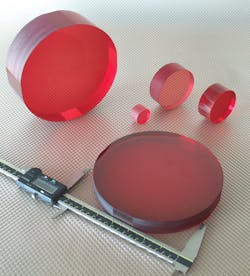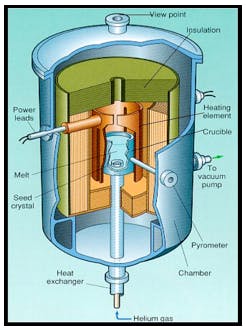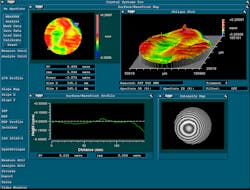HIGH-POWER SOLID-STATE LASERS: Ti:sapphire laser crystals reach 200 mm diameter
DAVID JOYCE, BILL RIPLEY, KURT SCHMID, and SCOTT COHEN
A number of laboratories around the world are constructing compact solid-state lasers capable of reaching petawatt levels and beyond. Such high peak powers are achieved by compressing a modest amount of energy into an extremely short time span, reaching extreme power levels for a few femtoseconds. These short pulses can be achieved using chirped pulse amplification (CPA).
The CPA technique allows a laser pulse to be stretched in time by more than a factor of 103. The resulting less intense pulse can then be safely amplified by passing it through a large-diameter gain medium, followed by recompression to the original short pulse length at the final step in the optical train. Additionally, CPA allows energies to be dramatically increased without producing nonlinear effects or surpassing damage thresholds for laser optics.
Titanium-doped sapphire (Ti:sapphire) is the preeminent gain material for these ultrafast lasers. It has excellent mechanical and thermal properties, has a high laser damage threshold, and, most important, has the widest emission bandwidth of any laser-gain material, spanning 680 to 1100 nm. Through modelocking, the pulses are compressed in time, with the amount of compression proportional to the emission bandwidth. Due to its wide bandwidth, a Ti:sapphire laser can compress these pulses to less than 10 fs, allowing extremely high peak powers to be reached with a given pulse energy.
Because the maximum amount of compression for Ti:sapphire laser pulses is unlikely to increase much, peak-power increases will require higher pulse energies. The saturation fluence of Ti:sapphire limits the amount of energy that can be extracted from a given area of the gain medium to about 1 J/cm2. Thus, the ultimate limitation of the output energy is imposed by the available crystal size. For a Ti:sapphire crystal in a laser system to have an active aperture of 150 mm in diameter, growth of boules 200 mm in diameter or greater is necessary. In response, we have pushed our crystal-growth technology to produce the world's largest Ti:sapphire boules (see Fig. 1).
Growing high-quality Ti:sapphire
Since 1988, we have grown Ti:sapphire for the solid-state laser industry using the heat-exchanger method (HEM). Here, Ti:sapphire boules are grown from a melt in refractory metal crucibles (see Fig. 2). This approach has many advantages over other methods. For instance, in HEM, growth is achieved without movement of the crucible, heat zone, or crystal; this stable environment contributes to ideal conditions for high-temperature crystallization. After growth, the chamber is held in an isothermal condition so that in-situ annealing can reduce residual stress as well as the defect density in the newly formed crystal.One of the most important attributes of the HEM technique is the consistent crystalline structure that is produced over a large aperture. This uniform structure yields excellent refractive-index homogeneity, which is necessary for multipass amplification in a Ti:sapphire laser. A bow-tie beam-path configuration–typically used to amplify laser light within the crystal–requires four successive passes through the crystal. Crystals with good homogeneity enable four-pass amplification without introducing nonuniformities into the beam profile.
Another important attribute is that HEM boules are produced so that Ti4+ ions are suppressed in the crystal lattice. The Ti4+ ions contribute to an absorption band that is centered at the fluorescence wavelength of 800 nm. This parasitic absorption robs the laser of energy and is a major crystal quality parameter, expressed as the figure of merit (FOM). In laymen's terms, FOM is the ratio of "good" absorption ( at 532 nm) to "bad" absorption (at 800 nm). Other non-HEM crystal-growth techniques rely on post-growth processing to reduce the Ti4+ ions formed during growth. However, with large-diameter amplifier crystals, post-growth processing is ineffective at reducing the Ti4+ ions that are intrinsic within the structure. Because the HEM technique grows an intrinsically high-FOM material, it is uniquely capable of producing large, high-quality amplifier crystals.
Need for large-diameter Ti:sapphire
For more than 20 years, HEM Ti:sapphire boules with 4 and 6 in. diameters satisfied all possible laser-rod configurations needed by the industry. The largest amplifier crystals produced in the 1990s were slightly greater than 100 mm in diameter. The many technical bottlenecks in the CPA laser systems (including gratings, other optics, and pump lasers) precluded laser designers from moving to larger Ti:sapphire amplifier crystals. Recently, however, several laser systems have been proposed that will reach petawatt-level peak powers, and thus will require sizes on the order of 250 mm in diameter.
One of the preeminent laser systems in development is the 25 PW beam line at the Institut de la Lumière Extrême (ILE; Palaiseau, France). This single beam line will deliver 25 J of energy in 15 fs pulses at a repetition rate of 1 shot per minute. This groundbreaking laser system represents the first step on the path to even more powerful laser systems that will be built in Europe under the umbrella of the European Extreme Light Infrastructure (ELI). The objective of ELI is to provide the worldwide scientific community with unique laser facilities allowing investigation of the so-far-unexplored domain of laser-matter interaction at 1023 W/cm2 and beyond.
The ELI scientists identified several technological bottlenecks and in turn raised funds to generate solutions to these roadblocks. In particular, these systems will require high-quality Ti:sapphire amplifier crystals up to 250 mm diameter. This new requirement has led to the launch of a 200 mm diameter development program at Crystal Systems, funded by the ILE. The program called for scaling up boule growth from 6 to 8 in. diameter while simultaneously improving crystal quality. Ultimately, the ELI platforms will require even larger crystals with active apertures up to 250 mm diameter.
Development of 200 mm boules
The first stage of the program involved the upgrading of a commercial growth furnace and the growth of 10 boules with 8 in. diameters. The second stage will involve even larger boules that will yield 250 mm diameter laser crystals. Crystal Systems started the program by reengineering a growth chamber to accommodate large-sized crystals. The furnace design criteria called for increased control over process variables. Ultimately, a new furnace with upgraded size, efficiency, and controls was designed and built to specifications.
The first attempts at scaling up the growth from 6 to 8 in. yielded mixed results, as many different variables needed to be understood and assimilated into the growth recipe. After making several changes to the equipment and the recipe, the fourth crystal was produced to near perfection. The crystal contained no light scatter or bubbles and exhibited excellent homogeneity of refractive index. This boule was cored and polished and then underwent a multistep inspection process for scatter, absorption at 532 and 800 nm, and transmitted wavefront error (TWE). The final crystal was fabricated, super-polished, and coated to produce the largest ever Ti:sapphire amplifier crystal, greater than 170 mm in diameter (see Fig. 3).It was decided that a strong focus should be placed on maximizing the path length of the Ti:sapphire crystals to combat the effects of transverse lasing. Therefore, additional process changes were introduced to increase the length of the crystals. These changes required further adjustments to the growth recipe and furnace hardware. Success in crystal growth was reached after refining the proportion of titanium to overall mass of the crystal. The seventh boule came out with excellent material properties and was suitable for another amplifier crystal of 170 mm in diameter with a path length around 40 mm. Several more high-quality boules were grown in this chamber with the same growth recipes.
Based on the repeatability and the scalability of this growth furnace and related technology, as well as the financial merits of the new furnace design and growth recipes, we decided to transfer the new technology into "normal production" design. The new production furnace would make new sizes of Ti:sapphire amplifier crystals available to industry. This transfer to production would serve as the final validation of the technology development. The new Ti:sapphire furnaces were built with the same approach as the experimental furnaces and were given the normal "shake-down" runs before being put into production on commercial orders. These production furnaces have successfully produced boules of the same size and quality as the original experimental furnaces.
This evolution of crystal size and quality will not stop at a 200 mm diameter, as the industry will need up to 250 mm diameter crystals in the next four years to achieve ELI's ambitious plans. Crystal Systems expects to make these larger sizes available to the marketplace within this time period using the same scale-up concepts that have applied to the 200 mm project.
ACKNOWLEDGMENTS
The authors would like to acknowledge the contributions of David Maxwell (Ti:sapphire technician) and Frederick Schmid (president) of Crystal Systems, and Judy Schmid of Upper Case Design.
David Joyce is director of research and development, Bill Ripley is senior sales representative, Kurt Schmid is chief operating officer, and Scott Cohen is sales representative at Crystal Systems Inc., 27 Congress St., Salem, MA 01970; e-mail: [email protected]; www.crystalsystems.com.


